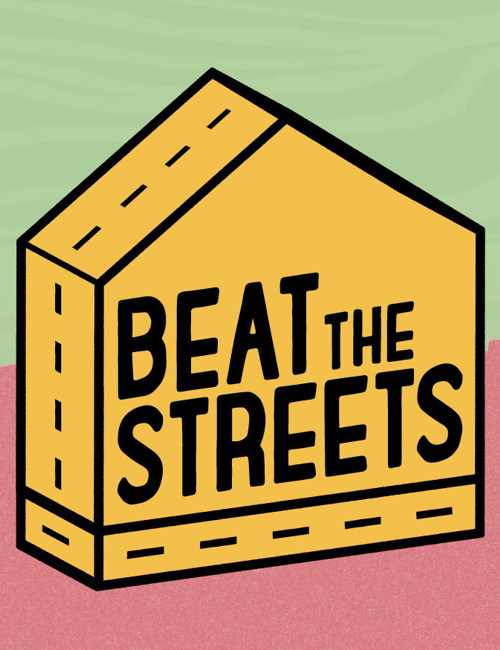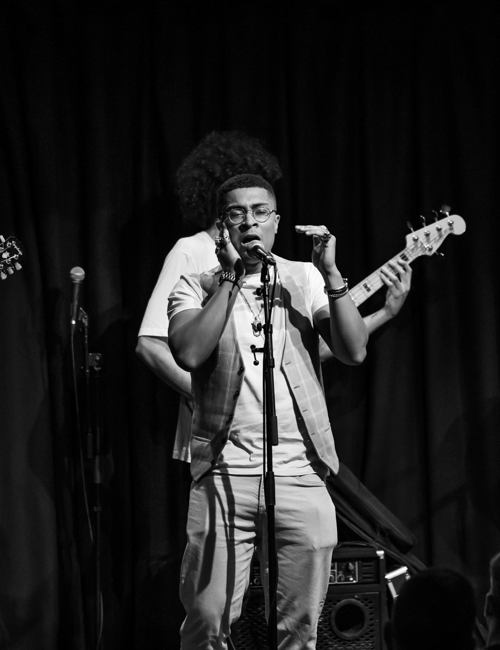St Ann’s Community Recording Studio (CRS) is a legendary Nottingham institution lighting fires in the bellies of the city’s young people. After setting up in 1991, the facilities have seen the creation of local music legends like Scorzayzee, Lee Ramsey and Nina Smith, as well as today’s rising talent in the form of Young T and Bugsey, Jamal Sterrett and Nartz, to name but a few. Beyond musical projects, the registered charity acts as a source of support and guidance for youths, whacks on theatre productions, makes feature-length films, and has recently started to dabble in the fashion world. We thought it was high time we delved into the history of the organisation, and found out what’s buzzing in and “out da ville” these days…

Trevor Rose, or “Big Trev” as he’s more commonly known round these parts, acted as the main founder of CRS back in 1991, but he maintains that it was a movement that grew from a multitude of creative heads on the scene, at a time when studios were business-focused. “We were an amalgamation of young people who were involved in music,” says Trev. “For example, Nick [Sterrett, Studio Manager] was involved through a band, and I was doing a bit of breakdancing. There ended up being about 45 of us who were all just like ‘You know what? We’re gonna do summat.’”
Local youth worker and friend Delroy Peterkin told the troupe to get their heads together and apply for a local grant, so Trev and friends took the advice. Originally taking up residence in the belly of St Ann’s, in the ACNA Centre in Hungerhill Road, the plan was to run a three year project in developing music and media, using the funding to buy a load of equipment. “It revolutionised our way of moving,” says Trev. “We were able to do what we wanted in our own unit in the centre.”
Nick Sterrett aka “Nick Stez” has been at CRS from the start too, now acting as Studio Manager, Producer and Youth Worker. He explains how they started stepping it up back then: “Craig Chettle [CEO, Confetti] used to have a studio at his, and he did a demo tape for our band. He knew a lot about equipment, so we got his advice on what gear to buy.”
“We got a S3000 AKAI Sampler; the equivalent of the iPhone 8 now,” says Trev. “When it came out it, it revolutionised editing and sampling because it had longer sampling time. The FZ1 we used to have got you about five or ten seconds that you could extend if you slowed the rate down, but the AKAI S3000 gave you something like three minutes if you slowed it. I remember opening the boxes and setting all the gear up. With the S3000, the manual was so thick, but it went over the shoulder and we just started pressing buttons.”
“We ran it with an Atari ST computer, because in those days you couldn’t record audio into a computer, you had to sync it,” says Nick. “The great thing, though, was that because it was really limited, you had to be really creative.”
“You had one room, with forty young people and one computer,” continues Trev. “If you didn’t reach a certain point, you couldn’t touch the mic. Now, there’s access to a multitude of laptops, headphone units and computers. The kids just run in here like ‘Yeah, let’s get some music up!’ whereas in that day, kids would just look and go ‘Wow, I’ve gotta work towards that.’ It was about building up your levels, showing your confidence. There was no way we were just gonna stop the whole room and record that one person if they couldn’t even do something. They would be like ‘Can I get the headphones on and go in the booth?’ and we’d say ‘Yeah, one day.’”
“We had a small set and a big set,” says Nick. “The goal was to get on the big set, so it gave them that drive and they knew it had to be good.”
Among the hungry youths of the nineties were a collection of individual rappers and singers who couldn’t stay away from CRS. Lee Ramsey, Scorzayzee, Tempa, Karizma, C-Mone, Fidel Castro, Instinct, Becky, and Sophie Johnson-Hill are just some of the people who were around in the early days, and who would go on to formulate the label and hip hop group Out Da Ville alongside Nick, Trev and DJ Fever.
“We wanted to get St Ann’s name out there,” says Trev. “We started out as Real Deal Records, but there was an internationally famous shop in London called Deal Real Records and they contacted us straight away like ‘Hang on a minute.’ If I’m really truthful, there was another name we had – 95 Records – which shows you the year we started. People kept saying to me ‘Well, what about when it becomes ‘96?’”
Following the initial naming dilemma, the collective went on to name themselves Out Da Ville. “Everyone always called St Ann’s ‘Ville’,” explains Trev, “and it was kind of synonymous with rap slang and rap culture. ‘Where you from?’ ‘We’re from Ville!’ We were ready for a global takeover, so it became Out Da Ville. Not all the kids were from St Ann’s, but the mindset and the fortress we were building was coming out of the Ville. Everyone would recognise it.”
Going on to release UK hip hop classics like Blood, Sweat and Tears, the crew began working with labels like Sony, EMI and BMG, as well as artists like Groove Armada, More Fire Crew and The Prodigy. But even when being featured on and managed by MTV, there wasn’t much money being made from the labours of Out Da Ville, with the collective continuing on for the love of killing mics up and down the country for around ten years. “Looking back, what threaded them together is that they were all kind of underdogs,” reflects Nick. “They weren’t all the cool kids.”
“Lee Ramsey was a young kid that we just found there on the street,” says Trev. “He was like four foot seven with a coat that was three sizes too big and a baseball cap just covering his eyes. But he was larger than life, had a real good energy, and was very creative lyrically. He could just freestyle; you’d give him a mic and he just wouldn’t shut up, and he had all the confidence in the world. They used to call him ‘Super Kid’, because everybody else who rapped was in their early twenties, and we had this thirteen-year-old who you could put in the room with all the grown men. He brought his mate, who we called ‘S’ back then, who became Scorzayzee. When we first had him, Scorzayzee used to have a very average haircut and a mouth brace; he was definitely not the epitome of the LL Cool J type.”
“He had a terrible time back then. We were really strict,” says Nick. “But thinking back to most of them, the strictness helped them shape their craft. I’m old school; my piano teacher used to hit me on the knuckles if I went wrong, so I’ve come from that. I think it’s just being so passionate, we want it to be right. Now, we’ve mellowed with age.”
On top of being a place to develop music, CRS acts as a place of support and guidance for the city’s young people. Initially, it was all about the music for Nick and Trev, and as the organisation gathered recognition for its ability to speak to and connect with Notts’ youth, people began to reach out and utilise what was being created.
“The local council had a project going with a local drug awareness worker, and they wanted to run some sessions that involved the kids learning about the dos and don’ts,” says Trev. “The woman had a great insight: ‘You’ve got a room with a load of young kids in there. We’ll give you £1,500 if we can run twenty sessions over a certain amount of time.’ At that point, we became really aware of the responsibility, and realised that we had a business.”
The budgets harnessed from running various youth engagement projects meant Nick and Trev could pack in sessional factory work and commit to the organisation full time, as well as reinvest funds back into making the music that fuelled the whole thing. Eventually, CRS became a registered charity, going on to receive support from the Royal Foundation, and implementing interventional schemes like Full Effect in 2014, to prevent youth violence and crime, with Prince Harry himsen making several appearances at the studio.

These days, there’s all sorts of creative work being developed out of CRS, which now sits in Lowdham Street. As well as the continued strive for musical prowess, there’s theatre, film, dance, and now fashion being churned out of the building. Released back in 2013, feature-length film The Chase looks at teenage life in inner-city Nottingham; Nott Romeo and Juliet was a collaboration that saw the Birmingham Royal Ballet work together with dancers from the city to create a performance at Nottingham’s Theatre Royal; Look Sharp: The Barbershop was a hip hopera at Nottingham Arts Theatre that told a story through rapping. And that’s not even scratching the surface.
Current Youth Engagement Worker at CRS, and artist in his own right, Jourdan Pierre Blair talks about seeing the end result of the hip hopera as being one of the most memorable moments in his time at CRS: “These kids had never acted, some of them had never even performed before, and to see them smash that show... I got kind of emotional. I remember looking to Nick and being like, ‘They really killed it.’ To see them perform in front of a big crowd was kind of overwhelming. They were all running around signing autographs, and it made them feel important. That’s what it’s all about, really; some of them feel worthless, like they don’t belong anywhere, but to see them like ‘Yeah, we’re important, people wanna interview us and recognise us’, it was good to see. That’s what I’m here for, that’s my reward.”
Jourdan, who you might recognise as Jah Digga, started attending CRS as a teenager, using the facilities to record songs as a young rapper. After many years grafting away at his music, Jourdan was offered a job as a Youth Engagement Worker. “Trev and Nick are good guys, humble guys, and not just in music but as mentors, too,” he says. “They grew me from when I was a young tearaway doing things I shouldn’t have been doing. I was knee-deep in the streets, I was gang affiliated, I was doing all that mad stuff. I went to CRS as a kid and it was like ‘Wow’. They believed in man, and it’s the same with today’s kids; they come here and it’s like a family, you can come here and be yourself.”
Far from a mainstream school or college, there’s a relaxed atmosphere at CRS that makes for an interesting learning environment. Now an established supporter of the city’s young people, Jourdan talks about breaking down the boundaries that traditionally exist in educational institutions. “I’m a worker, I’m a friend, I’m an artist, and I’m a fan of some of these young people,” says Jourdan. “I'm a different generation to these kids; I grew up listening to Nas, but this lot will tell me what’s good these days. We can sit down and have that dialogue, we can have that debate. We’re all learning off each other.
“It’s like Young T and Bugsey, we can sit down and talk for hours. They’re doing really well and they’ve come through us. They were really trying to master their craft and now they’re conquering England; they’re making national noise. When I see that, it’s amazing. I’m a fan, and I can’t wait for them to bring out their new music.”
With acts like Young T and Bugsey getting major deals, it’s reminiscent of times past. Although Out Da Ville broke up some years ago, Nick and Big Trev continue to fuel the future Lee Ramseys and C-Mones of the city, but with a slightly different approach to mentoring these days. Nick explains: “Because we’ve all got our own Instagram and Facebook, there’s now a bit of ‘You can’t tell me nothing, because I’ve got 200,000 views, mate’. All you can do is share your experience and gently guide.
“I do struggle with it because I’ve come out of a ‘That’s rubbish, do it again’ mentality. Now, it’s more ‘That’s OK. Go home and practise, come back next week and we can try it again.’ We’ve become more sensitive. But we also learn things off young people, like new techniques and different ways of looking at music, new creative ideas. Then, we were a bit more blinkers-on, a lot more hardcore, and the sound reflected that; now, the music is a bit more mellow and a bit more wavy.”
With most members of Out Da Ville going on to make more music, set up their own labels, and even get involved in television work, the phoenixes continue to rise from the ashes of what was. “A ninja warrior can only last so long; at some point he’s gonna say ‘I might go college’,” says Trev. “And it’s quite funny to see a lot of people ten years down the line like ‘Oh yeah, I remember you’, or being able to say to the new young people ‘What? You didn’t know your mum was a rapper?’”
Looking back at the work that’s gone down at CRS over the years, it’s undeniable the amount of influence the organisation has had on the local area. Jourdan agrees: “I think it’s massive, I’m the evidence. Don’t get me wrong, we can’t save the world… it’s only a small place with two or three rooms. But I tell you now, if CRS wasn’t there, some of those young people would be out doing things that they’re not supposed to be doing. I can say ‘Yes, we’ve saved a few lives’ and we’re gonna carry on saving a few lives. I just want to see more good news than bad news. I don't want to see young kids on the front page of the Nottingham Post getting fifteen to twenty years. I want to see Young Ts and Bugseys signing Sony deals, kids being in movies, or being on Eastenders.”
Jourdan is just one of many to have moved up the ranks at CRS, and who’s now giving back to the community after years of being propelled through by Nick and Trev. “They’re like the super mentors who’ve passed the knowledge onto me, it’s a cycle. I’m gonna pass the baton on and support the younger people who’re going through the same kinda struggles that I went through. The same thing Nick and Trev have done for me, I’ll do for them.”
CRS are currently running a Crowdfunder for new fashion label project St.Anndard, where young people will have the chance to take part in workshops ranging in everything from design, to marketing and project management. Get donating, duck.
CRS Live, a showcase of the organisation’s young musical talent, is taking place at Rough Trade on Wednesday 21 December, from 6pm.
Community Recording Studio, Lowdham Street, St Ann’s, NG3 2DP. 07921 845 763
CRS website
We have a favour to ask
LeftLion is Nottingham’s meeting point for information about what’s going on in our city, from the established organisations to the grassroots. We want to keep what we do free to all to access, but increasingly we are relying on revenue from our readers to continue. Can you spare a few quid each month to support us?




